
Chapters
Click on any link shown in Blue and then use the Back Button to return to this Page
Sumatra 1942
Map of Malaya and Sumatra
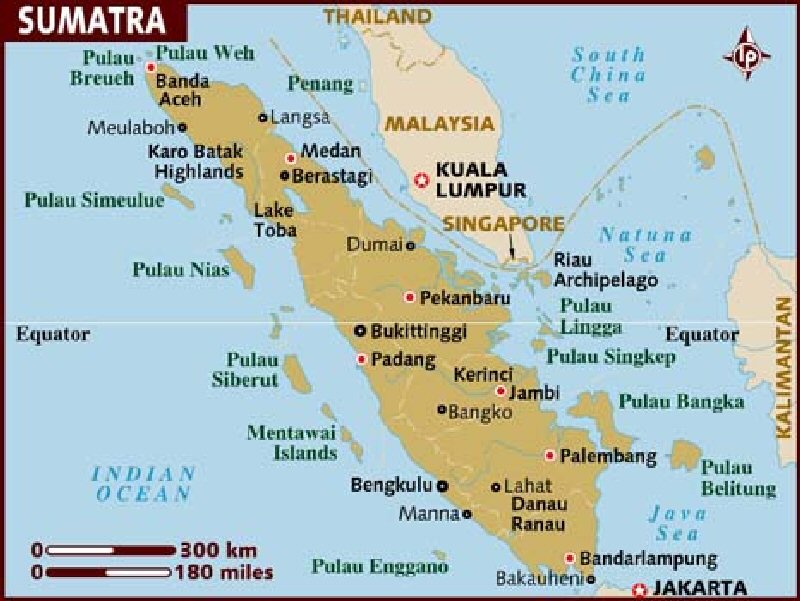
Map of Palembang
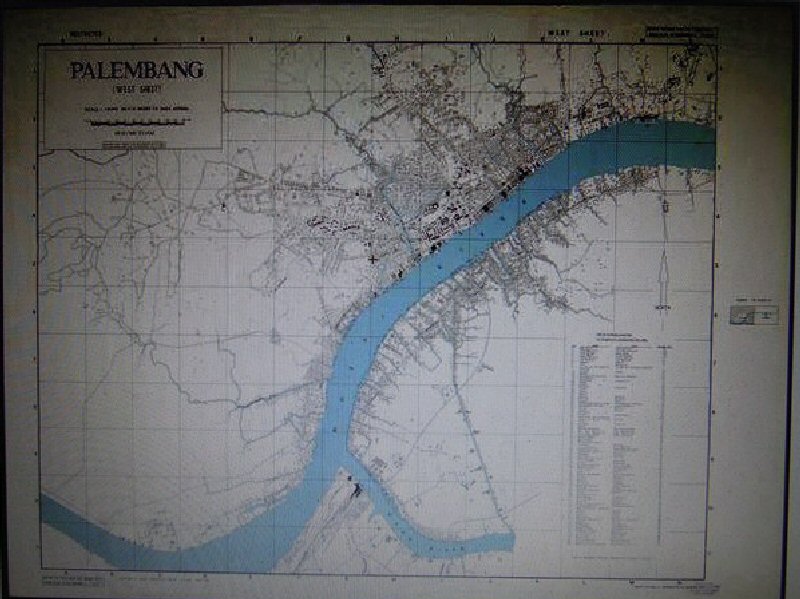
Map of the Initial Prisoner of War camps
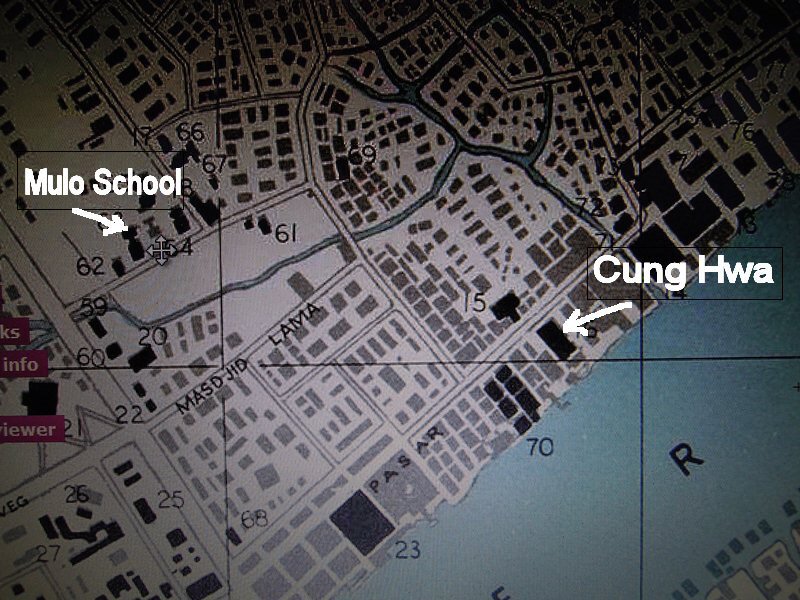
Sumatra before the Japanese Invasion
Battle for Palembang
Japanese Paratroopers Land in Palembang
Invasion of Sumatra 1942
Photographs of Dutch Indonisia (This is a Dutch Web Site , click on the Union Jack to get it in English)
Images of Palembang
Dutch Website
On Arrival to Palembang , Sumatra , my father might have spent some time in Hua Chiao School , before being transfered Chung Hua School , this was designated as camp 'B' and the prisoners of War held there consisted of mostly "Other Ranks" from Banka Island Plus some Officers and some Dutch captured in Palembang , the Senior British Officers at Cheung Hwa were Lt Col Hill March and later CMMDR Reid RN. Chung Hua was a bug-ridden two storey building divided into small rooms , in each room was crammed about twenty men. The main building was square in shape , with the rooms arranged around the edges of a kind of hall , the second floor rooms opened up to a balcony which over looked the hall. There were various outbuildings which formed annexes to the main building. There was also a large unpaved space euphemistically called the playground . which the POWs later used to light their fires to brew up their tea and to cook some stolen rice ,until it was stopped. Along side the school ran a dirty little stream .There were also various little courtyards between the buildings.
Other Camps in Palembang :-
Mulo School was used for the Officers , RAF , RN and Australians along with some Dutch shipped from Muntok, Banka Island were placed in Camp 'A' at Mulo School with the Senior British Officer being Air Commodore Modin.
"C" Camp , Located at the back of Mulo School , comprising of men capable of manufacturing things for use in the other camps . It was closed on 19th Aug 1943 then re-established at Sungai Geron in April 1944 .
"O" Camp , "Officers Camp" , Senior British Officer Lt Col Hill comprising of Five Bungalows in Palembang housing 85 British and Dutch Officers plus 10 "Other Ranks" . Considered the best camp in Palembang . All were transfered to Mulo School in November 1943 then to Sungei Geron March / April 1944.
A short extract from "Prisoner of Nippon" by Ray Stubbs " In other rooms the Liverpudlians and the Scousers . clanned together in a tough , uncompromising band , matched perhaps by the Geordies, with their almost , impenetrable language barrier , understood in the main only by the border Scots."
For the next two or three weeks the POWs languished about , slowly losing the will to live and waiting for the next meal of rice which was signaled by the ringing of the school bell. The first rations of rice consisted of 'Limed Rice' , this was rice that had been treated by the Dutch so it would improve is keeping qualities , but this treatment did not improve its flavor or its colour , and when cooked took on a greenish - yellow hue.
One of the first actions undertaken by the Senior British officer CMMDR Reid RN was to ask the Japanese whether work of a non military nature could be found for the POWs , this action was met with disbelief and anger by the POWs against the Commanding Officer ,but his action almost certainly prolonged and saved many lives , because the POWs now had something to occupy their days and also provided opportunities to steal food and materials that would help the POWs survive . All POWs stole anything that they thought would be use full and they could smuggle it back into the camp . The risks undertaken for stealing were considerable , the POWs if caught would face at least a severe beating or even death from the Japanese.
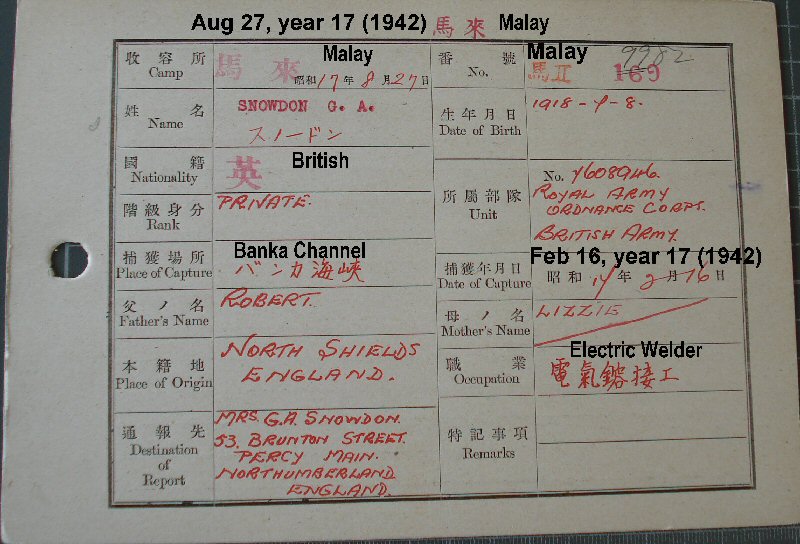
This is my Fathers Japanese POW Index Card , Front View (with English Translations)
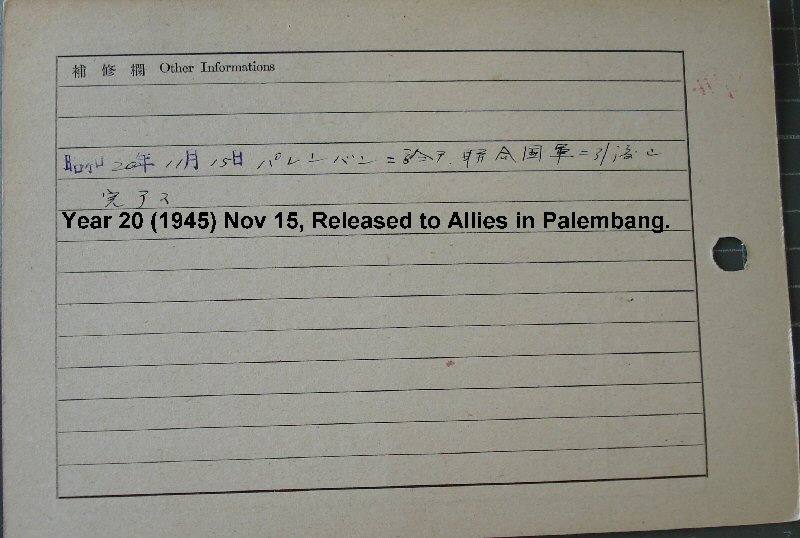
Back View (Prisoners were evacuated in September not November)
An attempted escape took place were two Royal Navy men , Petty Officer Britt and seaman Barber , taking an opportunity will working outside the camp made a break for it with some money , spare cloths and a few other bitts and pieces collected from their fellow POWs . At the next "Tenko" (Prisoner Count) the rest of the POWs covered for the two escapees and the POWs escape was not discovered for three days , when all hell broke loose , the Japanese discovered that the two men were Navel Personnel so they took out their anger on the men from that service , punching and kicking them , the men who shared a tent with the escapees were kept standing all day and as the light faded they were in turn badly beaten . About a month or two later , two disheveled men were brought into Cheung Hwa , they both had straggly hair and beards and their skin was burnt deep brown , their eyes were sunken and their emaciated bodies displayed every bone . The two new prisoners were handed over into the Commanders Keeping and two new names were added to the roll Blake and Jackson , they were of course Barber and Britt , but had the sense to change their names when they were captured , but they were unable to have any communication with, or from England.
The two men had escaped from the working party in a Sampan left be some Chinese native , they spent two days on the river and then started on land . After about four days they came across a hut and spent two days there Blake suffering a touch of malaria . On the second day they were confronted by a native , but the escapees managed to make him understand they wanted to go north , they native took them to a jungle path and the POWs spent a day walking along and came across a Chinese Kampong , the Chinese took them in and they stayed for a week and then journeyed on . They met som Malays and were taken back to their village and given some food, they next thing they knew was two Japs at the hut door with fixed bayonets , they were put on a lorry and taken to Djambi and there they were put into jail. When they went before the commanding Jap Officer he wanted to know who they were and where they came from , Barber and Britt said that their ship had been sunk and they had swum ashore and made their way through the Jungle . They were put back in jail and finally taken back to Palembang , luckily for them the Japanese believed their story otherwise they both would have been executed.
One of the biggest problems facing the POWs was illness , due to a lack of food , which manly consisted of about 400 to 500 Grams of Rice per day , and the unsanitary conditions , the POWs soon began to suffer from a range of tropical diseases one of which almost all of them suffered , Dysentery .
"Dysentery is an intestinal inflammation, especially in the colon, that can lead to severe diarrhea with mucus or blood in the feces. Patients typically experience mild to severe abdominal pain or stomach cramps. In some cases, untreated dysentery can be life-threatening, especially if the infected person cannot replace lost fluids fast enough."
- Bacillary dysentery, caused by Shigella, a bacterium. In Western Europe and the USA it is the most common type of dysentery among people who have not recently been to the tropics.
- Amoebic dysentery (amoebiasis) This is caused by Entamoeba histolytica, a type of amoeba, and is more common in the tropics. An amoeba is a protozoan (single-celled) organism that constantly changes shape.
There was very little medical supplies in the Japanese Prisoners of War camps , so treatment of Dysentry would have been difficult and of cause their dietary needs were totally inadequate , as a result many POWs died of this single illness alone .
Most of the prisoners in Cheuge Hwa were detailed to work on building an extension to the Palembang airstrip , despite objections from the CO , Commander Ried on the grounds this was military work prohibited by the "Geneva Convention " , his protests were ignored . This was hard physical work , especially on the POWs meager rations . The POWs would be transported early every morning to the Airport and returned very late in the evening . Sometimes the lorries would break down and the POWs would be left stranded without food or water until replacement Lorries arrived . It eventually dawned on the Japanese that it would be better to build a new camp closer to the Airport , this was known as Camp P1 and was a very basic camp . When the work on the Airport was complete many of the POWs were taken to Mulo School. The rest of the British and Australians at Cheuge Hwa were transferred to Mulo School as well .
Conditions at Mulo School were much better than Cheuge Hwa and were almost luxurious compared to the P1 camp near the Airstrip. One new thing the Inmates had to learn was the use of water instead of toilet paper , because the toilet facilities at this Indonesian School were not made to cope with traditional Western method of toilet hygiene . The Moslem method of washing the appropriate part of the anatomy with the left hand while holding the water with the right (Right hand is used for eating with !) .Not long after the POWs from the airports camp P1 arrived at Mulo School , the Japanese issued a Yellow Parole form , which they ordered the POWs to sign . The form was a guarantee that the POWs would not attempt to escape . The CO Commander Reid reiterated to the Japanese Authorities that it was the duty of all British , Australian and New Zealanders to try and escape from captivity , and his message of 'no signing' was communicated to every prisoner. The Japanese were furious and replaced the Sikh guards with brutal Jap guards , they cut the rations and stopped the few medical supplies . The Japanese did not want to lose face and were determind to make the POWs sign the guarantee form and were determind to see the prisoners sign or die .
The Japanese threatened to send all the POWs back to the squalor of the Cheung Hwa School , which now housed the Dutch POWs who had signed the guarantee forms . The POWs still refused to sign the forms so the Japanes ordered the prisoners to leave the better camp at Mulo School and travel the two miles to Cheung Hwa School .
The POWs settled into Cheung Hwa , all British POWs together and it became a well organized camp , the men were sorted out into Messes determined by their service , Naval personal were put together in the upper rooms of the main building and the Army personnel were housed in the rooms below. The few RAF personnel were housed in out buildings whilst the Officers were housed in a building facing the main building. The guards were housed in a guard room that immediately faced the entrance to the camp. The senior British officer was Commander Reid RN.
The impasse of the Prisoners not signing the guarantee form dragged on for about two weeks , the POWs were basically put on a starvation ration and the beatings off the guards became more and more frequent , finally Commander Reid decided that it would be better to sign the guarantee and advised the POWs to sign . Most of the prisoners did not sign against there own name and some added "under duress" , but finally the Rations were increased and the POWs were fit enough to go out to work .
The camp was so well organized that the life of the POWs was bearable , but the clothes worn by the POWs were by now totally thread bear , so the prisoners began to make a type of loin cloth , nicknamed the 'Fandooshie'
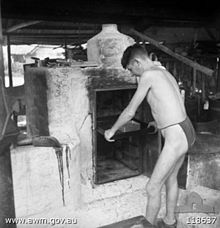
The 'Fandooshie' (loin Cloth)
It was easy to make and maintain and the added benefit of it was it could be used to hide "loot" pilfered by the POWs when out in working parties , there was a Mark 2 version with a pocket sewn in internally so that the "loot could be loaded into it so that it just rested between the crutch making it harder for the guards to detect.
Boots were another item that wore out quickly so the POWs improvised by making clogs out of roughly shaped wood held on to the feet by a strap across the toes . Another clothing item made by the POWs was any sort of hat to protect them from the the Sun .
Working parties were allotted different tasks depending on the requirements of the Japanese after the morning 'Tenko' (Japanese for counting) . these tasks could be unloading ships , timber , drums of fuel oil or if the POW was lucky , food and a chance to steal some to supplement the meager rations from the Japanese . The food ration fro the prisoner was :-
A small plate of porridgy rice in the morning
The same amount of rice for lunch
In the evening they got a very watery green vegetable soup with a portion of boiled rice.
There was also an ample supply of 'Rat' !
The CO of the camp decided that the POWs should be paid by the Japanese for the work they were doing and the application was passed to the Japanese authorities stating that unless the Prisoners of war were paid , they would have the status of 'slaves' and as the Japanese always referred to the POWs as their guests , it would be better to pay them at least a token amount . The Japanese , much to the surprise of the POWs agreed and the amount each working POW received was 10 Cents per day. The buying power of 10 Cents was not great , you could get one banana or half an egg or half a cake wrapped in a palm leaf , but in a very short time the buying power became so low that the POW would have to work a week just to buy an egg !
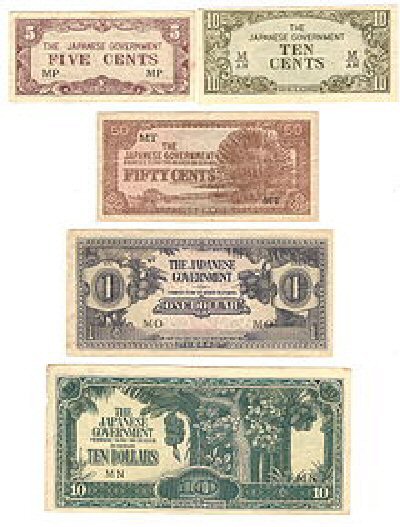
Japanese occupation money 1942 -1945
The reason why the money had less and less purchasing power was the the Japanese Occupation Authorities printed the paper money without any gold reserves to back it up.
The Japanese were not allowing any contact with the native population, so the POWs were allowed to open up a shop so that they could spend the money they eared . The shop was run by two POW sergeants and any profits made went to the hospital and sick fund , the sick did not get paid as they were unable to work. With the shop opening the POWs now had an excuse if they were caught with something not issued by the Japanese they would have been in serious trouble but now they could say that they bought it at the shop. Before the shop opened the POWs took extraordinary risks to buy or barter with the Chinese natives , the Indonesians were very reluctant to trade with the POWs because they were afraid of being caught and punished by the Japanese . The Chinese on the other hand hated the Japanese and were only to glad to trade with the POWs . The Japanese had mistreated and even massacred the Chinese right across Malay , Singapore and Indonesia and of course were still fighting in China itself .
There was a change of guards , Korean soldiers were brought in to replace the Japanese squad , under the command of Japanese N.C.O , the Korean attitude to the POWs was the same if not worse towards the POWs . The Japanese had 'colonized' Korea in 1910 and their soldiers were used by the Japanese in many theaters of war throughout south east Asia most notably as POW guards . The Japanese had recruited many Korean girls , with all kinds of false promises , only for them to end up as prostitutes for the Japanese Army . So naturally the Koreans hated the Japanese and the Japanese treat the Koreans as an inferior race to themselves often handing out beating to them , the POWs often bore the brunt of this resentment and they themselves were often used to bear brunt of the Korean Guards frustration .
In October 1942 my father was transferred into a new Regiment , the Royal Electrical and Mechanical Engineers (R.E.M.E) from the Royal Army Ordnance Corp (R.A.O.C) , although he would not know this until his liberation in 1945.
Life in Cheung Hwa became a routine of working parties and the ever present hunger pangs , but new filtered throughout the camp that the war was turning against the Japanese , and the American forces were moving across the Pacific.
At the beginning of 1944 rumors that the POWs were to be moved to a new camp circulated , This camp was going to be built by the POWs themselves and would be call Sungei Geron
NEXT CHAPTER : BACK TO TOP